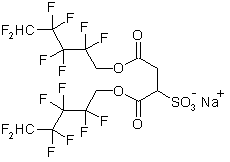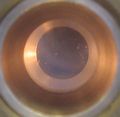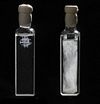| Julian
Eastoe Research Group
Sarah Gold |
|||
|
Last updated 25-01-2006
|
CO2 Much
work on the use of CO2 as a solvent has been carried out with
the intention of finding a 'green' replacement for common VOC's (volatile
organic compounds). Unfortunately, CO2 is generally a very
poor solvent, particularly for polar and/or high molecular weight
solutes, and this places severe limitations on potential applications.
A good way to overcome this, and hence enhance solubility in
condensed CO2, would be to incorporate reversed micelles or nano-droplets
in a CO2-continuous phase.
Ideally, these systems would be water-in-CO2 (w/c)
microemulsions, stabilized using CO2-compatible surfactants. Past research has shown
that fluoro-surfactants such as di-HCF4 (figure 1) are the most
effective moieties for stabilizing w/c systems.1 These
however, are prohibitively expensive as well as incompatible with
current green aims for this area of research
Figure 1 - Di-HCF4 With this in mind, research is now focusing on understanding what structural features allow for surface activity in CO2 with a view to using these molecular functionalities to design effective, cheap and ecologically responsible surfactants for use in w/c systems. Important work in this area by Wallen & Raveedren et al. has shown that the presence of carbonyl groups (figure 2) enhances the solubility of hydrocarbons in CO2.2 Molecular simulations carried out by the same workers has suggested that this increase in surfactant activity is due to lewis acid - lewis base interactions between the carbonyl oxygen on the surfactant, and electron deficient carbon in the CO2 molecule.3
Figure 2 - a- and b- 1,2,3,4,6 pentaacetyl-D-glucose, both show activity in CO2 Previous work carried out by A. Paul and S. Nave within this group has uncovered that highly branched chain tips as in AOT3 and AOT 4 (figure 3) can also boost the solubility of surfactants in condensed CO24 and this has been attributed to the lower cohesive energy densities which is a general feature of highly branched alkyl chains.
Figure 3 - a) AOT 3 and b) AOT 4 - CO2 soluble surfactants incorporating highly branched chain tips It would seem logical then, that surfactants which incorporate both carbonyl functionality and high branching in chain tips would be an obvious next step in the ongoing search for effective hydrocarbon CO2 surfactants.
Gallery Below are some pretty pictures & video clips of some samples I have made during my PhD
1. Eastoe, J.; Cazelles, B.M.H.; Steytler, D.C.; Holmes, J.D.; Pitt, A.R.; Wear, T.J.; Heenan, R.K. Langmuir 1997, 13, 6980 2. Raveendran, P.; Wallen, S.L.; J. Am. Chem. Soc., 2002, 124, 7274 3. Raveendran, P.; Wallen, S.L.; J. Phys. Chem. B., 2003, 107, 1477 4. Eastoe, J.; Paul, A.; Nave, A.; Steytler, D.C.; Robinson, B.H.; Rumsey, E.; Thorpe, M.; Heenan, R.K. J. Am. Chem. Soc. 2001, 123, 988
|






